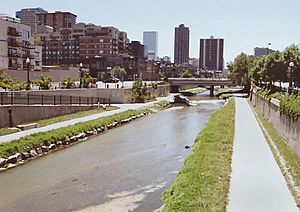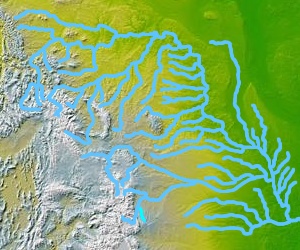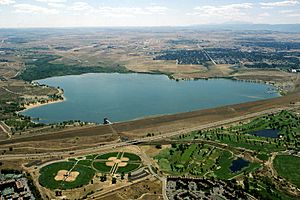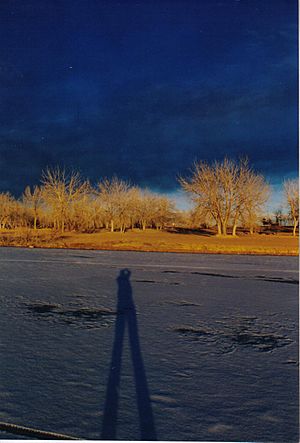Cherry Creek (Colorado) facts for kids
Quick facts for kids Cherry Creek |
|
|---|---|

Cherry Creek in Denver
|
|

Cherry Creek's location in the western part of the Missouri River watershed, highlighted in light blue
|
|
| Physical characteristics | |
| Main source | Confluence of West Cherry Creek and East Cherry Creek 39°17′08.7″N 104°42′59.0″W / 39.285750°N 104.716389°W |
| River mouth | Confluence with South Platte 5,167 ft (1,575 m) 39°45′16.4″N 105°00′29.6″W / 39.754556°N 105.008222°W |
| Basin features | |
| Progression | South Platte—Platte— Missouri—Mississippi |
Cherry Creek is a river in Colorado, USA. It flows for about 48 miles (77 km) and eventually joins the South Platte River. This creek is an important part of the Denver area. It is known for its interesting history, natural beauty, and fun outdoor activities.
Exploring Cherry Creek's Journey
Cherry Creek starts in a high, flat area called a plateau. This is located east of the Front Range mountains in northwestern El Paso County.
Where Cherry Creek Flows
The creek flows north through Castlewood Canyon State Park. Here, you can see the old Cherry Creek Bridge crossing over it. It then passes by towns like Parker, Centennial, and Aurora. Finally, it reaches southeast Denver.
As it moves through Denver, Cherry Creek becomes an urban stream. This means it flows through a city area. It joins the South Platte River at Confluence Park in central Denver. This spot is very close to where the city of Denver was first started in 1858.
Cherry Creek Dam and Reservoir
A large structure called the Cherry Creek Dam was finished in 1950. This dam is about 140 feet (43 meters) high. It creates the Cherry Creek Reservoir. This reservoir is inside Cherry Creek State Park.
The dam helps control floods and provides water for farming. It is located near the city limits of Denver and Aurora. This is about 8 miles (13 km) from where the creek meets the South Platte River.
Places Named After the Creek
The creek gives its name to several local spots. These include the Cherry Creek neighborhood in south-central Denver. It also names the popular Cherry Creek Shopping Center. The local school district, Cherry Creek Public Schools, is also named after the creek.
You can enjoy the Cherry Creek Bike Path. This path follows the creek from Confluence Park in downtown Denver. It goes all the way through Cherry Creek State Park and south towards Parker.
Cherry Creek's Past: Gold Rush and History
Cherry Creek played a big role in the early days of the Pike's Peak Gold Rush in 1858 and 1859. This was when gold was found in the "Cherry Creek diggings." At that time, this area was part of western Kansas Territory.
The very first newspaper, the Rocky Mountain News, was published on April 23, 1859. Its masthead said it was located at "Cherry Creek, K. T." Gold was also found near Russellville (now in Douglas County). This was in the upper part of the Cherry Creek area. Gold was also found where Cherry Creek meets the Platte River.
Speer Boulevard runs along Cherry Creek. It is part of Denver's system of parks and parkways. This boulevard is important enough to be listed on the National Register of Historic Places.
Wildlife and Nature Along Cherry Creek
Cherry Creek is known for its interesting wildlife. Many different creatures live in and around the water.
Aquatic Life in the Creek
The creek is home to many crayfish. Some people even catch and eat these small crustaceans. You can also find many small fish here. These include young trout, sunfish, crappie, and yellow perch.
Sometimes, when the Cherry Creek Dam opens its floodgates, larger fish come downstream. These can include rainbow trout, brown trout, bigger sunfish, walleye, and even northern pike.
The creek's natural environment faced challenges during a drought in the early 2000s. Plants along the banks were damaged. This caused more natural waste to fall into the water. This made it harder for the water to have enough oxygen. Less water flow also meant pollutants were not washed away. Things like fertilizers and bug sprays built up. The water also got warmer, which made the problem worse. Luckily, by 2005, the creek became much healthier.
Animals on the Banks
The area around Cherry Creek is also home to many snakes. You might see garter snakes, western hognose snakes, bullsnakes, and sometimes even rattlesnakes.
Amphibians that live in Colorado can also be found here. These include the plains leopard frog, Woodhouse's toad, and the striped chorus frog. However, the bullfrog, which is not native to this area, has also moved into Cherry Creek. In recent years, bullfrogs have caused problems for the native amphibian populations.
Plants and Trees Along the Creek
For some parts of its journey, especially near Four Mile Historical Park, the creek has woods and bushes on both sides. This area is kept mostly wild. It is one of the few places in the Denver area where you can still see the creek's namesake plant, the chokecherry, growing wild.
Large trees like cottonwood and willows are common. You might also find edible plants like wild asparagus and prickly pear. Other plants like Virginia creeper and imported plants like the Russian olive and dandelion are also present.
Even though this wild area is not very wide, many animals live here. You can often see raccoons, beaver, foxes, coyotes, and even deer along the creek. Beavers usually build their homes upstream, but they swim downstream to find food.
Fossils and the Creek's Flow
You can find a lot of Petrified wood in the creek. It washes down from old "petrified forests" upstream. Sometimes, you can even find fairly large pieces. Bones of ancient mammals have also been discovered here.
Records from what is now Four Mile Historical Park show that before the Cherry Creek Dam was built, the creek's water level changed a lot. It would rise and fall regularly. But since the dam was finished, this natural cycle has stopped. Now, the flow of the creek is mostly controlled by the dam's operators.
The creek's level usually stays the same. However, when water needs to be released from the Cherry Creek Reservoir, the dam's floodgates are opened. When this happens, the creek's water level can rise by as much as two feet. This can happen very quickly, sometimes in less than an hour.



